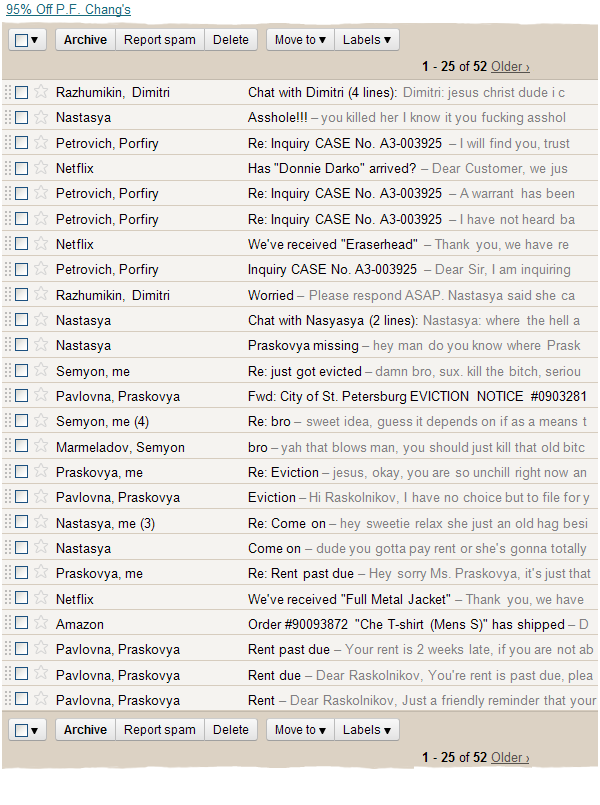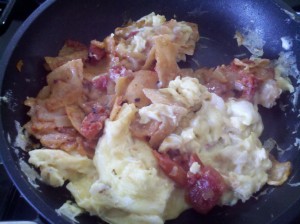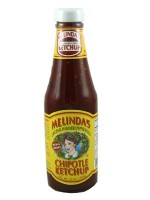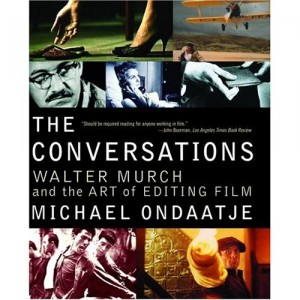The BBC did an End Notes feature on the legacy of David Foster Wallace, which you can stream at their site here, or can download as an mp3 here [w/ thanks to my pal Eric].
Raskolnikov’s inbox
[Best if read bottom up for chronological order.]

Towlie, Towle & Bean Spasms
It often happens that I return to the same books I want that are like really expensive. Like the Notebooks of Paul Valéry. Anyway I want a copy of this slick little book so bad it makes me think it a stupid thing to want a book so bad, like I should be wanting things like sex drugs and money so bad, but I just want this little book so bad, with a nice simple cover by Joe Brainard. The cheapest I have seen so far is $300. It is collected in Ted Berrigan’s Collected Poems.
Recipes for Writers: Migas
 If Chickpea Curry is my number one dinner all-star for cooking without shopping, then my lunch/breakfast/brunch all-stars are fried rice and migas, which I think of in my head as tortilla eggs. I’ll do fried rice once I make/photograph it; today is all about migas, which I made yesterday. Basically, I make fried rice if I have leftover rice and stir-fry or vaguely Chinese leftovers, and I make migas if I have vaguely Mexican leftovers or bits of Mexican-y ingredients and corn tortillas. Flour tortillas might be good too but I’ve never tried it.
If Chickpea Curry is my number one dinner all-star for cooking without shopping, then my lunch/breakfast/brunch all-stars are fried rice and migas, which I think of in my head as tortilla eggs. I’ll do fried rice once I make/photograph it; today is all about migas, which I made yesterday. Basically, I make fried rice if I have leftover rice and stir-fry or vaguely Chinese leftovers, and I make migas if I have vaguely Mexican leftovers or bits of Mexican-y ingredients and corn tortillas. Flour tortillas might be good too but I’ve never tried it.
The only essentials for migas are tortillas and eggs. And hot sauce or salsa or something similar. Yesterday, I ate it with some Melinda’s Chipotle Ketchup that I bought at Marshall’s (it’s a really great Marshall’s. I also got sesame oil and walnut oil).
At left, not-migas; unhappiness. Below right, migas; less unhappiness. Below left, Melinda’s Chipotle Ketchup; happiness.
Other bits that go well in migas:
Mushrooms
Red onions, scallions or other onions

Leftover chicken or beef or pork or shrimp or tofu
Jalapenos or other chili
Poblanos or bell peppers
Spinach
Leftover cooked potato or sweet potato or squash
Tomatoes / tomato sauce / tomato paste
Avocado
Cheese
 Yesterday, all I had were eggs, tortillas, shredded Colby-Jack, and leftover tomato sauce from when I served handmade cheese tortellini. So the tomato sauce already onion and garlic in it.
Yesterday, all I had were eggs, tortillas, shredded Colby-Jack, and leftover tomato sauce from when I served handmade cheese tortellini. So the tomato sauce already onion and garlic in it.
Here’s the method: Cut all your non-egg, non-sauce ingredients in little bits. Tear the tortillas into bits (around 1-inch square but precision is NOT necessary and indeed frowned upon because it’s good to have some crispier bits and some softer bits and besides tortillas are round). Beat eggs, with milk if you like, salt and pepper. Heat some fat (vegetable oil, butter, say about 1 tablespoon per egg, at ~2 eggs per person) in a pan/skillet. Add all the non-egg non-sauce non-cheese bits including the tortillas (but if you are using avocado, for the love of god add that at the end). Season with salt and pepper and fry in the oil till they get to desired softness/brownness/doneness. Add eggs, sauce, cheese (which you could have also added to the eggs in the beating stage). Kinda scramble those eggs with everything until cooked. Eat with hot sauce/salsa/Melinda’s Chipotle Ketchup.
Research Questionnaire: On Reality TV

Reggie Bush and Kim Kardashian - "Keeping up with the Kardashians"
1. Do you watch reality TV?
–If yes, which shows and why?
–If no, how come?
2. Why do you think reality TV is so popular today?
3. What do you think reality TV reflects about our society?
4. Are there connections between realism in contemporary literature
and realism on TV?
5. Does realism on TV seem “more real” or “less real” or “different real”
than realism in contemporary literature?
Do You Know?
What is a prose poem, a flash fiction? They are both bastardy forms. Fuck, they should be hanging out. Simpatico, I feel. Or at least enough I walk your toad, you walk mine. Fueled on hops and piss. I guarantee you Max Jacobs would have bought. both forms a dank. aperitif. Hell, so would Kim Chinquee. But, noooooooooooo. So. So. Tell me. What is the difference? Fire away.
Emily +/- Dickinson
Last night for school I was asked to give a brief presentation on the importance of Emily Dickinson’s dashes. (I posted about this a few days ago.) My one sentence conclusion: “They’re nearly as important as the words are.” yeah ok whatever…
I did some further reading, though, and noticed/learned something I think is interesting: even among the “accepted,” contemporary, “dash-inclusive” collections of her work, the dashes still aren’t fully represented the way she wrote them in her manuscripts… and I’m not just talking about the hypen vs. en dash vs. em dash thing, but even their placement and existence.
Let’s get into some shit…
Arts, Process, Edit
 In France*, cheese-making is really two processes. On dairies, milk is collected from cows, goats, or sheep, is cultured, maybe cooked, somehow molded. That is the first process. After that, an affineur takes over. The whole job of an affineur is to age cheese. Keep it at the right temperature, rotate it, maybe dust it off from time to time. When you hear about cheese caves, that’s the affineur part. In the small-producer cheese world, the affineurs are the stars, the ones whose name you would know if you worked in that industry. Pierre Androuet, Herve Mons, Marcel Petite (O the Comte from the cellars of Marcel Petite!). One affineur might get wheels from several different trusted dairies, whose names never make it on the packaging (unlike in the US, where most cheeses seem to be branded by farm/dairy).
In France*, cheese-making is really two processes. On dairies, milk is collected from cows, goats, or sheep, is cultured, maybe cooked, somehow molded. That is the first process. After that, an affineur takes over. The whole job of an affineur is to age cheese. Keep it at the right temperature, rotate it, maybe dust it off from time to time. When you hear about cheese caves, that’s the affineur part. In the small-producer cheese world, the affineurs are the stars, the ones whose name you would know if you worked in that industry. Pierre Androuet, Herve Mons, Marcel Petite (O the Comte from the cellars of Marcel Petite!). One affineur might get wheels from several different trusted dairies, whose names never make it on the packaging (unlike in the US, where most cheeses seem to be branded by farm/dairy).
So it goes with films–the editing is done by someone else, not the director or screenwriter. Walter Murch was the editor and/or sound editor (he’s the only person to win Oscars for both) of Apocalypse Now, The Godfather II, The Conversation, and many many others. His work on The English Patient acquainted him with Michael Ondaatje. The two had a series of conversations/interviews (Ondaatje is asking the questions, primarily) that are collected in a book called The Conversations: Walter Murch and the Art of Editing Film.
The book is a trove. I’ve been meaning to write about it here for over a year (!), but I’m still not all the way through it. Obviously, I’ve put it down a lot, but also I just really want to take my time with it because there is so much to learn and reflect on. I’m fascinated by how these two men, both of whose work I adore, find these nexuses between film editing and book editing. It’s a reminder of how much we as word-people have to learn from people who work in other media. The reason I started with the cheese example is that the big overarching thing the book makes me think about is the relationship between making and aging/editing/tending/revising. Below are a few passages that stood out for me. But really, you should have this book. It was assigned to me in grad school by the great Susan Bell, author of The Artful Edit, which, if a friend hadn’t made off to California with my copy, would get its own post. But with all respect to Bell and Stunk and White and the rest, The Conversations is the best writing manual (not that it’s trying to be) that I’ve ever read. So, here are some bits (O for Ondaatje and M for Murch):
M: It’s a stage in the process I call “editing with eyes half closed.” You can’t open your eyes completely, which is to say, you can’t express your opinion unreservedly. You don’t know enough yet. And you’re only the editor. You have to give everything the benefit of the doubt. On the other hand, you can’t be completely without opinion, otherwise nothing would ever get done. Putting a film together is all about having opinions: this not that, now not later, in or out. But exactly what the balance should be between neutrality and opinion is a very tricky question. The point is, if you squash this down, then you push the whole curve of the film down, whereas it might have righted itself by its own mysterious means. If you try to correct the film while putting it together, you end up chasing your own tail.
Appropriating an appropriation of an appropriation
Kate Durbin has posted images from Andrea Quinlan’s copy of The Polished You, which Kate produced for Vanessa Place’s Factory Series, which Vanessa describes as her version of Warhol’s practice of having “art-workers” help him create his paintings.
You can read more about the Factory Series here. And you can check out the whole series at Ood Press.
Plus, you, too, can appropriate the text created by Kate created by Vanessa created by Nancy Taylor, by purchasing a copy of The Polished You. After making it your own, you can scan the images of your copy and send them to Kate and she’ll post them.
I love this project for a bunch of reasons, not least of which are the many questions it raises about authorship, ownership, consumption, production, participation, and whether or not the idea of appropriation is merely the evil connotation of personalization.


